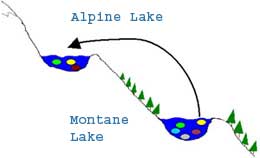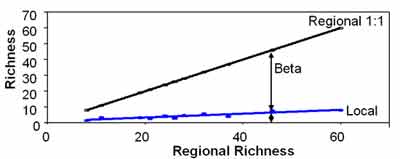
Introduction
Publications
Climate Change
Industrial Impacts
Agricultural Impacts
Urban Impacts
Biodiversity Loss
Definitions
Links
Site Map
|
 |

Does Environmental Warming Increase Invasion of Alpine Zooplankton Communities by Montane Species?

What is Expected?
Climate warming is expected to stress coldwater species in alpine lakes, and consequently, allow species from warmer low-elevation, montane lakes to invade and alter ecosystem structure. However, this scenario assumes that zooplankton are not dispersal-limited and can migrate up mountains in response to climate warming. For example, a 1ºC warming of mountain lakes would requires zooplankton species to ascend ~100 m to find a lake that has a suitable temperature.
Species migration, however, is limited by dispersal potential, chemical and physical barriers such as mountain ridges, and biotic factors such as predatation. Dispersal potential refers to the range that a species would occupy without human introduction.
Can Species Adapt?
The adaptability of freshwater organisms to climate warming is largely determined by dispersal potential and thermal tolerance. Thermal tolerance is the ability of the species to tolerate temperature changes in the environment.
Zooplankton Communities
Data for zooplankton communities from 379 lakes and ponds in the Canadian Rocky Mountains is being used to assess their dispersal potential and environmental sensitivity. The linear relationship between local (within-lake) and regional (among-lakes) species richness, or total number of species across a set of adjacent lakes, suggests that mountain zooplankton communities are dispersal-limited and not saturated with species. As a result, upward migration by zooplankton species to colder alpine lakes appears to be difficult. However, some species with relatively wide dispersal potentials should be able to successfully invade alpine lakes as they warm because resident zooplankton communities appear not to be saturated with species, and therefore, are open to invaders.
 |
| Local versus regional richness in number of species. Local richness is much lower, suggesting that these zooplankton communities are dispersal-limited. |
Page 1 Page 2
Back to Climate Change Page
|  |







